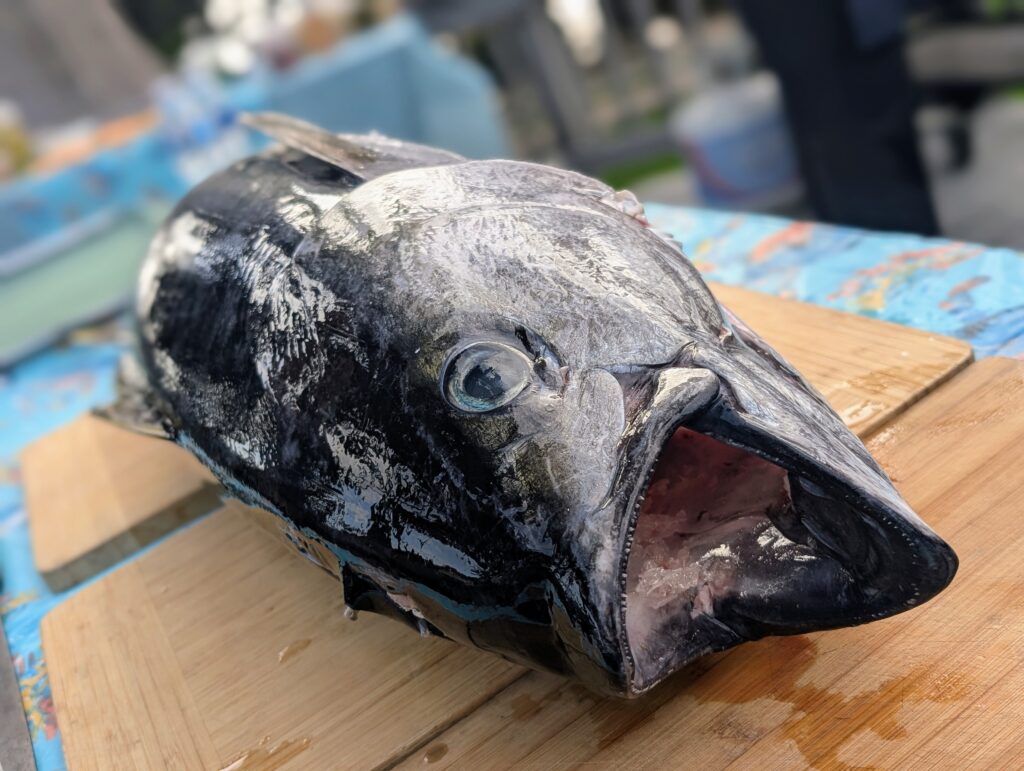
Oct. 24, 2025—The giant eyeball fell from the flimsy plate so fast I could only react.
My hand shot out to catch it midair.
Which meant, of course, now I had to eat it.
This was a very sudden development.
It was also part of a fish-butchering demo that kicked off an expansive week of fishery policy education in La Jolla, California, where I attended the Marine Resource Education Program (MREP), West Coast edition, on behalf of nonprofit Monterey Bay Fisheries Trust.
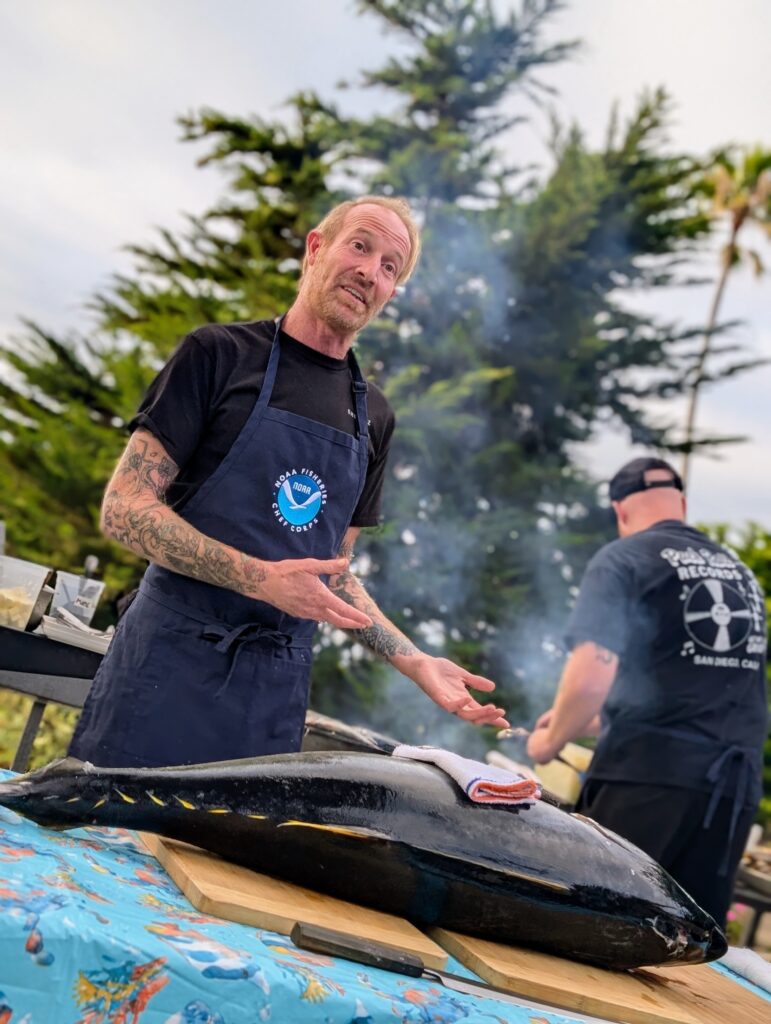
MREP’s purpose is to empower fishermen—who have so much on-the-water wisdom—to 1) resist being intimidated by an exhausting and bureaucratic management process; 2) contribute powerful insight to an inexact, albeit science-based, policy; and 3) take a proverbial seat at the table instead of finding themselves on it.
Oregon-based commercial fisherman, Pacific Council member and conference moderator Poggy Lapham put it in his own words during an MREP session hitting on how doers like him can contribute.
“It’s, ‘Hey, look at us as fishermen, who have a giant sample size of data,'” he said. “We have data around weather, gear types, fish populations and locations and a lot more—all things scientists don’t do every single day like we do. If we can’t help inform how those regulations are set, they’re going to be set by people who aren’t involved and don’t have a handle on applicability.
“I don’t want people telling me what, for instance, my gear should look like when they haven’t been out on a boat.”
The suddenness of the eyeball drop provided helpful contrast, as sudden is just about the opposite of the pace with which marine policy takes shape.
That was one fundamental lesson that emerged from 2025’s West Coast MREP.
Here appear a few others.
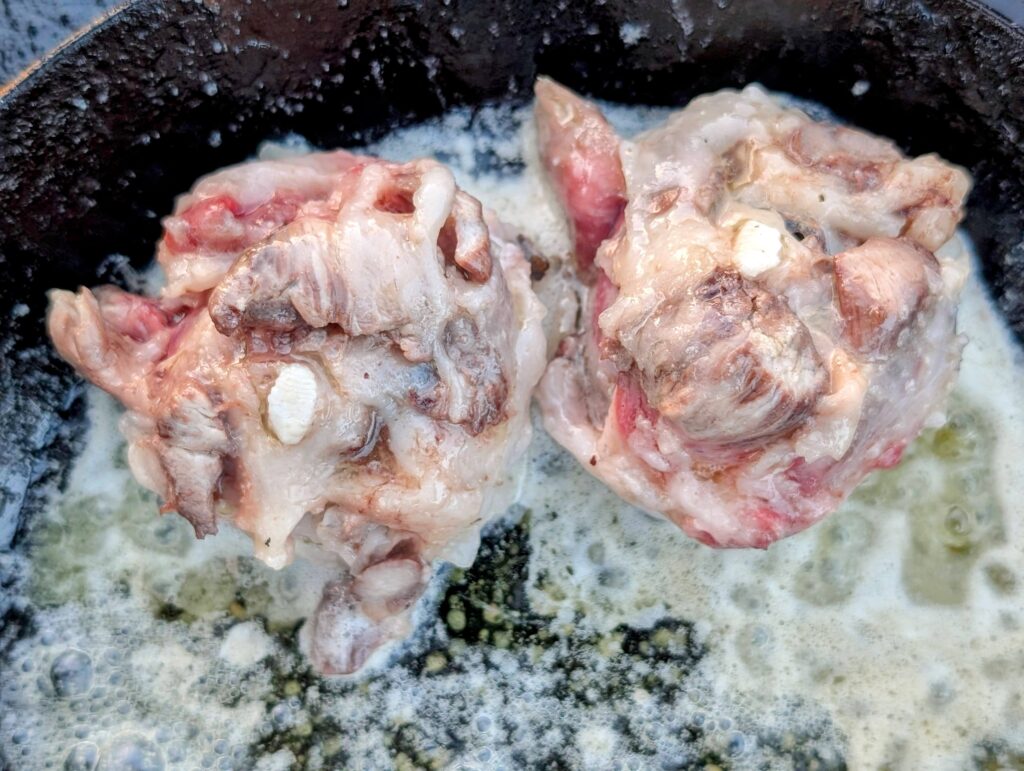
Lesson #1: Eyeballs can be delicious.
I have a new seafood hero, and I’m not alone in that allegiance.
With little more than his fellow cook, a chef knife and a shallow wood grill, celebrated chef and self-described “boundary-breaker” Davin Waite cleaned a huge bigeye tuna tip to tip with ninja speed, culinary institute-level lessons and cooking-show charisma.
That said, what the co-owner/operator of landmark Oceanside spots Wrench & Rodent Seabasstropub and Shootz Fish & Beer did best was 1) show how to use the entirety of a beautiful locally landed fish—including its eyes, heart, bone marrow, liver and even fins, bones and scales—to reduce waste and increase return; and 2) treat us to a Poseidon-grade seafood feast of snappy fresh sashimi, tender tartare, grilled cheeks, roasted collars, ribs, pastas, tostadas and more.
“It’s not a cheap restaurant owner thing, it’s a respect for the ingredient,” he said. “Let’s learn more and apply it…all this food and all these parts of the fish [are] more crayons for the box—and there are no bad cuts of meat if you’re using right.”
My plan with the eyeball was to leverage me trying one into getting MREP program principal and general fishery rockstar Lauren O’Brien to do the same.
Then she “accidentally” let one fall, my reflexes responded and my sway evaporated.
But we did test them out, and the Halloween-appropriate, tender, rich, and almost sweetbread-like muscles around the sclera were as tasty as Waite promised.
More on Waite and his partner/fellow eco-warrior wife at allthingswaite.com.
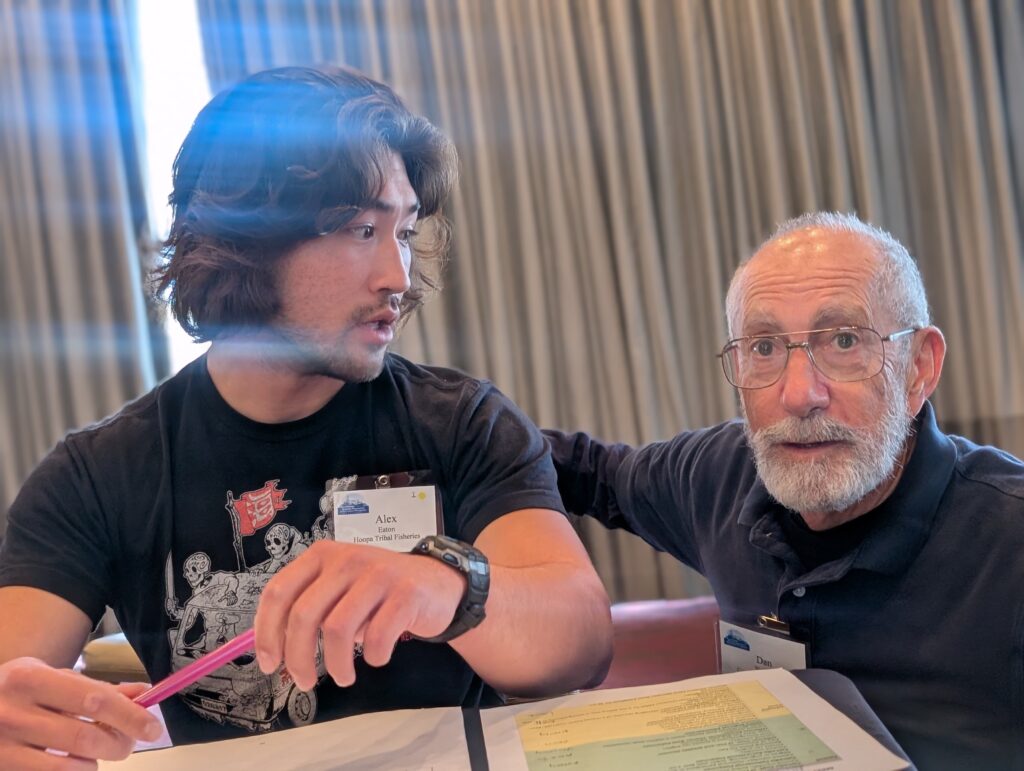
#3: U.S. ocean management is a mess. It’s also the best (for now).
Five times a year, the Pacific Fisheries Management Council, one of eight regional councils and by far the largest, meets for around 10 hours a day and up to seven days (not counting prelim meetings, prep, advisory council session or informal talks).
That makes sense, because PFMC oversees the best practices for fishing 119 species off the West Coast, including commercial, recreational, and tribal fisheries, and fish like salmon, groundfish, coastal pelagic species (sardines, anchovies, mackerel), and highly migratory species (tunas, sharks, swordfish).
Just the list of acronyms the Pacific Council uses number 423 (!).
My eyeballs dried out after just three hours of one such meeting in San Jose earlier this year. Watching kelp grow, by comparison, would be fascinating.
But as Monterey Bay Aquarium conservation chief Margaret Spring pointed out, the management structure represents the most powerful decision-making body that’s citizen run.
To help prepare fishermen and other attendees to inform that regulation in real life, the MREP team planned up an all-caps ELABORATE mock Pacific Council scenario.
We all assumed roles with conflicting priorities—as NGO environmentalists, fish and wildlife governmental officials, tribe representatives, commercial fishermen, recreational anglers and other fishing interests who all sit on the actual council—to hash out how to manage a fictional species called bossfish.
The dramatic dry-run came sparked by faux public comment, with extra helpings of consternation and compromise.
O’Brien helped put a button the realisitc chaos in the de-brief: “Fishermen’s voices are hugely important to make this system work.”
More at pcouncil.org. Look for additional takeaways from the 2025 West Coast MREP session via the Monterey Bay Fisheries Trust website.
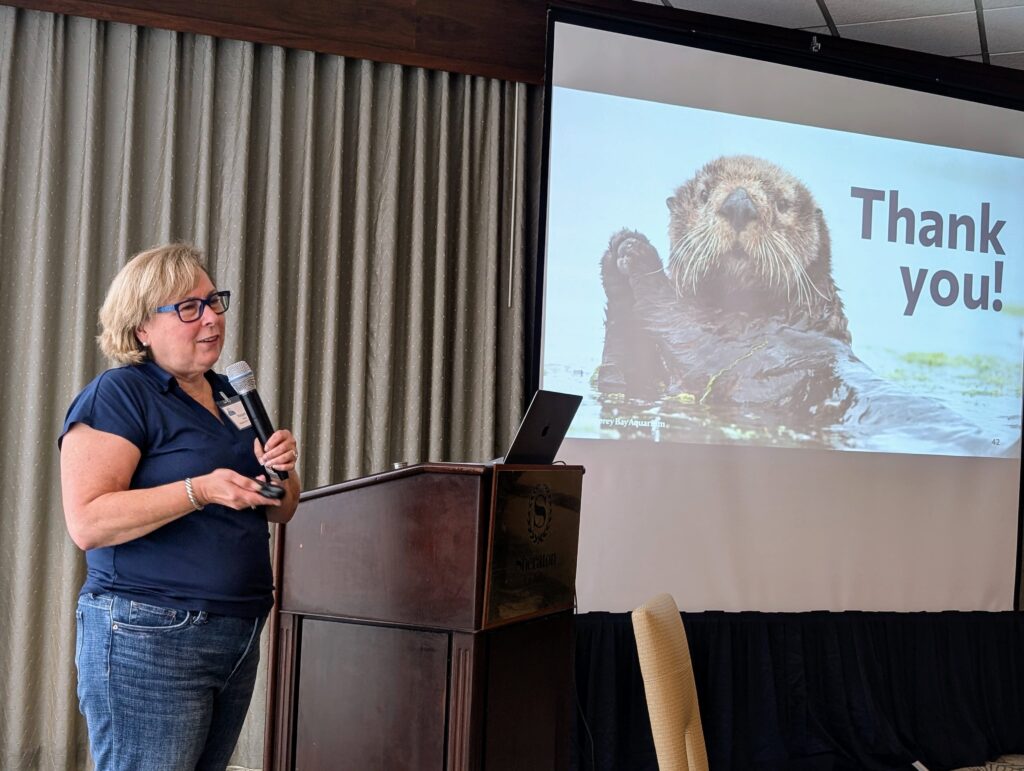
#3: Margaret Spring rules.
This was not news to folks in the fishery policy sphere, as the Carmel Valley resident and Monterey Bay Aquarium chief conservation and science officer been helping legislate a smart balance between conservation and commerce for decades.
That started on Capitol Hill when she was a U.S. Senate staffer, and came to include Monterey Bay.
Locally she helped co-found the MBFT—whose mission is to ensure sustainable fisheries, resilient communities, and a healthy ocean for the future—and only recently resigned after the Trust’s first 10 years to focus on preventing plastic pollution in the ocean.
What was revealing across her comprehensive presentation on the Magnuson Stevens Fishery Conservation and Management Act (MSA): How its laws (which created the regional councils that oversee the current fishing rules) made the United States the envy of the world when it comes to protecting waters within 200 miles of its shores.
Consider this: Before the paradigm-shifting Magnusson-Stevens Act you could spot trawlers from Russia and Europe off the New Jersey shore because national law didn’t define domestic water boundaries.
“The Magnuson-Stevens Act is an undisputed global management success story,” Spring said, “with a list of continuing challenges.”
Then came this twist, just in time for this piece.
Spring also retired from helping her winemaker husband Mark Bunter with their wine label Bunter-Spring for the same reasons she stepped aside with the Fisheries Trust.
But he had other things swirling.
I just learned their label has a surprise resuscitation on the way, soon, with a Saturday (Oct. 25) Wine Club Revival and BBQ at Big Sur Winery Tasting Room in Carmel Valley Village.
“We hinted our last wine club party was perhaps THE last,” the announcement reads, in what sounds like eternal Spring’s voice, with Halloween spookiness. “No more vineyard, last barrels bottled, fini.
“Since we didn’t have to make wine ourselves, this summer we got to go see how it’s done in Switzerland and Italy. Maybe bumming around vineyards and cellars revived the old geezer [Bunter], or maybe he just got bored, or guilt-stricken.
“Whatever the reason, the public should be warned. Apparently someone’s gonna have to put a stake through the winemaker’s heart.
“Just when you thought it was safe to go into The Village wine tasting again… Bunter Spring rises from the grave, and you feel the icy grip of the Undead Winemaker locked around your wrist, dragging you back in time.
“With promises of earthly delights and indulgence in wines thought long extinct, he reaches into your dwindling future to snatch away forever one more afternoon of your precious time on earth.
“Why resist? Had you planned something Saturday that will help this hapless planet and the doomed wretches spinning upon it? Ahh, yes, we thought not. So, help yourself, before it’s too late!
“Halloween is just ’round the corner. Before The Day of the Dead, you deserve an Afternoon of Living!”
You could call that welcome news.
And a sudden development.
More on Monterey Bay Aquarium’s fishery advocacy and MSA support via the MBA Educators tab.
About the author
Mark C. Anderson, EMB's managing editor and "Found Treasures" columnist, welcomes responsible and irresponsible feedback. Correspond via mark@ediblemontereybay.com.
- Mark C. Andersonhttps://www.ediblemontereybay.com/author/markcanderson/
- Mark C. Andersonhttps://www.ediblemontereybay.com/author/markcanderson/
- Mark C. Andersonhttps://www.ediblemontereybay.com/author/markcanderson/
- Mark C. Andersonhttps://www.ediblemontereybay.com/author/markcanderson/



